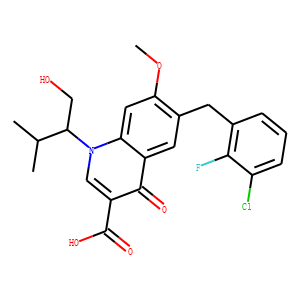| Reference | 1. Clin Pharmacol Ther. 2009 Jan;85(1):64-70. doi: 10.1038/clpt.2008.168. Epub 2008 Sep 24.<br />
Dose-response of ritonavir on hepatic CYP3A activity and elvitegravir oral exposure.<br />
Mathias AA(1), West S, Hui J, Kearney BP.<br />
Author information:<br />
(1)Clinical Research, Gilead Sciences, Inc., Foster City, California, USA. [email protected]<br />
Ritonavir, a potent inhibitor of cytochrome P450 isoform 3A (CYP3A) activity, is frequently used to boost the effects of protease inhibitors at doses of 100-400 mg per day; however, human data regarding the optimal dose required for boosting are limited. This study systematically evaluated the ritonavir dose-response relationship on presystemic and systemic CYP3A metabolism using the human immunodeficiency virus integrase inhibitor elvitegravir and midazolam as probe substrates. Ritonavir administered once daily with elvitegravir exhibited nonlinear pharmacokinetics, with a 119-fold increase in the area under the plasma concentration-time curve over the dosing interval over a 20- to 200-mg dose range. The 20-mg dose of ritonavir substantially reduced CYP3A-mediated clearance (CL), as evidenced by a 66% reduction in midazolam CL that plateaued to 17% of baseline activity at a 100-mg dose. Maximum inhibition of elvitegravir apparent oral CL was achieved with ritonavir doses of 50-100 mg. Elvitegravir and ritonavir were generally well tolerated in this study. These data provide a critical understanding of ritonavir's dose-response relationship for inhibition of CYP3A activity in humans.<br />
<br />
2. J Acquir Immune Defic Syndr. 2008 Oct 1;49(2):156-62. doi: 10.1097/QAI.0b013e318183a982.<br />
Effect of ritonavir-boosted tipranavir or darunavir on the steady-state pharmacokinetics of elvitegravir.<br />
Mathias AA(1), Hinkle J, Shen G, Enejosa J, Piliero PJ, Sekar V, Mack R, Tomaka F, Kearney BP.<br />
Author information:<br />
(1)Clinical Research, Gilead Sciences Inc., 333 Lakeside Drive, Foster City, CA 94404, USA. [email protected]<br />
OBJECTIVE: Elvitegravir (EVG) is in phase 3 development in combination with ritonavir (RTV)-boosted protease inhibitors in treatment-experienced, HIV-infected patients. Two studies evaluated pharmacokinetic (PK) interactions among EVG and RTV-boosted tipranavir (TPV/r) or darunavir (DRV/r).<br />
METHODS: Healthy volunteers received EVG/r alone (study 1: 200/100 mg once daily; study 2: 125/100 mg once daily), TPV/r (500/200 mg twice daily) or DRV/r (600/100 mg twice daily) alone, and EVG (200 or 125 mg as applicable) added to TPV/r (500/200 mg twice daily) or DRV/r (600/100 mg twice daily) in a randomized crossover design, with assessment of steady-state PK for EVG, TPV, DRV, and RTV. Safety was assessed by clinical monitoring. Studies were powered to conclude lack of an interaction if the 90% confidence interval for the geometric mean ratios of the AUCtau and Cmax for EVG, TPV, and DRV were within predefined no-effect boundaries. Trough concentrations were also assessed.<br />
RESULTS: No subjects discontinued for adverse events during treatment with EVG/r alone. On coadministration, AUCtau and Cmax of EVG and TPV and EVG and DRV were within prespecified no-effect boundaries versus treatment alone; trough concentrations were also not substantially altered.<br />
CONCLUSIONS: The PK of EVG and TPV or DRV were not altered after coadministration of EVG with TPV/r or DRV/r. EVG PK was similar with varied RTV doses of 100 mg once daily, 100 mg twice daily, or 200 mg twice daily. EVG can be added to TPV/r or DRV/r regimens without dose adjustment.<br />
<br />
3. J Acquir Immune Defic Syndr. 2007 Oct 1;46(2):160-6.<br />
Pharmacokinetics of coadministered ritonavir-boosted elvitegravir and zidovudine, didanosine, stavudine, or abacavir.<br />
Ramanathan S(1), Shen G, Hinkle J, Enejosa J, Kearney BP.<br />
Author information:<br />
(1)Gilead Sciences, Foster City, CA 94404, USA. [email protected]<br />
OBJECTIVE: To evaluate the potential for clinically relevant drug interactions between ritonavir-boosted elvitegravir (EVG/r) and the nucleoside reverse transcriptase inhibitors (NRTIs) zidovudine (ZDV), didanosine (ddI), stavudine (d4T), or abacavir (ABC) upon coadministration.<br />
METHODS: In 3 studies, healthy subjects were administered a single dose of ddI, d4T, or ABC, or multiple doses of ZDV, followed by multiple doses of EVG/r alone and together with an NRTI; pharmacokinetics (PK) of EVG and NRTIs were evaluated after individual administration and coadministration. Lack of PK alteration bounds (90% confidence intervals [CI]) for the NRTIs were based on the lack of PK-based dose adjustments per prescribing information.<br />
RESULTS: Twenty-four of 28, 32/32, and 24/26 subjects completed the ZDV-EVG/r, ddI/d4T-EVG/r, and ABC-EVG/r studies, respectively. All study drugs were well tolerated and no serious adverse events were noted. The PK of ZDV, its glucuronide (G-ZDV), d4T, ABC, and EVG were within the lack of PK alteration 90% CI bounds upon coadministration. Exposures of ddI were modestly (approximately 15%) lower, but these changes are unlikely to be clinically meaningful. CONCLUSIONS: There are no clinically relevant drug interactions between EVG/r and the NRTIs zidovudine, didanosine, stavudine, or abacavir. These agents can be coadministered without dose adjustment.<br />
|

